Threatened Species
Biodiversity is declining across the globe and in Australia today, 166 fauna and 556 flora1 species are listed as endangered.
Survey of Pygmy Bluetongue lizards at Tiliqua Nature Reserve
Once a species is listed as endangered, extinction is likely if not enough is done to save it. Nature Foundation is committed to the conservation of threatened and vulnerable species and we do this by investing significant resources into acquiring large areas of habitat that we manage for conservation. Our nature reserves create important biodiversity refuges to ensure the continued survival of threatened species.
We also assist in the protection of threatened species on private and crown land through our other conservation programs such as Water For Nature (WFN). Together with our partners, including the South Australian government and the Regent Parrot Recovery Team, WFN monitors and supports populations of threatened species such as the Regent Parrot, Southern Bell Frog and the Murray Hardyhead.
1 from the Federal EPBC Act list of threatened fauna and flora
Yellow-footed Rock-wallabies
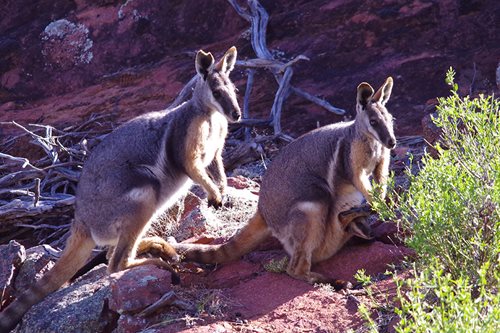
Yellow-footed Rock-wallabies at Hiltaba; photo Coral Johnston
The beautiful Yellow-footed Rock-wallaby (Petrogale xanthopus xanthopus), has been featured in the Nature Foundation logo since 1981, and represents both the vulnerability of nature, and our mission to conserve, protect and restore it.
The western-most colony of the Yellow-footed Rock-wallaby (YFRW), resides in the isolated rocky hills and granite outcrops at Hiltaba Nature Reserve.
Historically, YFRW’s were widespread on Hiltaba’s hills but when the property was acquired in 2012 the numbers were low and are now confined to one main colony.
With the assistance of donations and in partnership with Department for Environment and Water, we have implemented intensive goat and fox control around the colony. Recent monitoring via camera traps has enabled ecologists to keep an eye on the wallabies’ habitat use and the feral animals that threaten the species’ survival. There are encouraging signs of population growth.
As recipients of a Wettenhall Environment Trust grant in 2020 we purchased 10 radio collars for use on the wallabies. These provide real time positional fixes allowing ecologists to gain a better understanding of how the wallabies use the habitat.
An update on the Yellow-footed Rock-wallaby Recovery Program at Hiltaba Nature Reserve is available in a progress report which provides the background to the project, its objectives, and reports on the outcomes, and innovations arising from the work completed to date.
Pygmy Bluetongue Lizard

Pygmy Bluetongue at Tiliqua Nature Reserve; photo Patrick Mentzel
The Pygmy Bluetongue Lizard (Tiliqua adelaidensis) resembles a miniature version of the larger bluetongue lizard and was thought to be extinct but was rediscovered near Burra in 1992. At that time, 200 individuals were counted on a one-hectare area.
Some distinguishing features are a pink tongue, smooth, flat and overlapping scales, and a grey-brown to orange-brown body with no obvious stripes across or along the body. The tail is shorter than the head and body length and tapers to a point. Total length is no more than 20 centimetres.
Pygmy bluetongues take up residence in old trapdoor spider holes, often basking in the entrance of these during the warmer months. However, they are very sensitive to movement and will quickly retreat into their burrow if disturbed.
The secret of their survival seems to be twofold. Firstly, they only thrive on native grasslands that remain untilled. Secondly, it appears that these grasslands need to be grazed to some extent.
They are found in native tussock grasslands containing grasses such as spear grass, (Austrostipa), wallaby grass (Austrodanthonia) and the dark green iron grass (Lomandra). Iron grass is a good indicator of native tussock grasslands containing spear grass as it will not re-grow if the land has been ploughed.
Nature Foundation’s long-term research partner Flinders University was awarded a $400,000 Australian Research Council grant in early 2020 for a project aimed at saving the endangered Pygmy Bluetongue. We have committed an additional $25,000 to support the project over five years. In-kind support will also be provided, including continued access to our Tiliqua Nature Reserve and assistance in setting up the new trial site on a sheep farm at Tarlee.
Led by Associate Professor Mike Gardner, the project addresses significant issues surrounding the long-term survival of the species in a changing climate.
The late Professor Mike Bull of Flinders University and his researchers undertook multiple research projects at Tiliqua. You can support the Professor Mike Bull Research Fund.
Southern Bell Frog
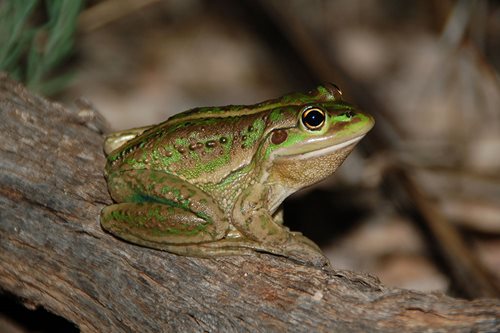
Southern Bell Frog; photo Callie Nickolai
The Southern Bell Frog (Litoria raniformis) is a larger frog and is bright green with gold coloured patches and large black or brown spots on its back. They were once widespread across the River Murray and south-eastern Australia but over the last 30 years populations have declined significantly and this species is now listed as vulnerable in South Australia and nationally. Changes to the frequency and timing of natural floods are among the key threats.
Over the past three years the program has replicated, as best we can, the natural wetting and drying cycle at a wetland on the Pike River floodplain near Paringa. In 2019, one single Southern Bell Frog was recorded in this location for the first time since 2010, and in 2020 up to a dozen were recorded. The return of the Southern Bell Frog to this part of the Pike indicates that plant and animal communities in this wetland and floodplain are being brought back to health.
By using the FrogSpotter app from Frogwatch SA local communities can monitor populations of the Southern Bell Frog and other frogs in their own local wetlands.
Mt Lofty Ranges Southern Emu-wren
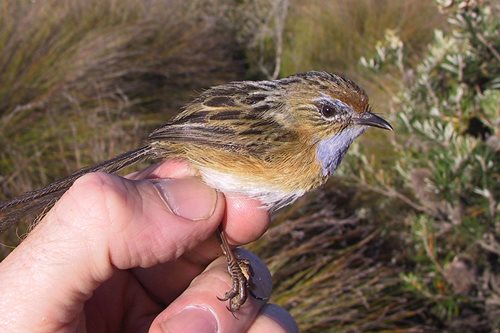
Mt Lofty Ranges Southern Emu-wren
The Mt Lofty Ranges Southern Emu-wren was named for its spectacular tail feathers, which can grow to up to 12cm in length. With a tiny body just 6cm long, it is one of Australia’s smallest – and shyest – birds.
The wren typically inhabits swamps and heathlands. However, in many areas these have been drained and cleared for agricultural development, and the birds have been significantly impacted by habitat fragmentation, and population numbers have fallen perilously low.
With as few as 250 individuals remaining, the Mt Lofty Ranges Southern Emu-wren is now classified as Critically Endangered and are found only on South Australia’s Fleurieu Peninsula.
Nature Foundation acquired Watchalunga Nature Reserve in 2015 with this specific conservation focus. The 92-hectare reserve comprises low lying Fleurieu Peninsula swamp and mixed samphire sedgeland at the mouth of the Finniss River, creating a vital haven for birdlife.
Latham’s Snipe
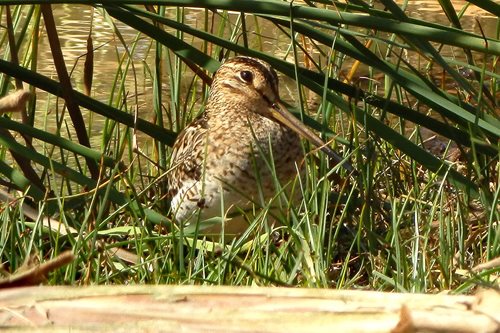
Latham's Snipe; photo Peter Koch
The Latham’s Snipe (Gallinago hardwickii) are migratory birds that fly more than 8,000 kilometres from Russia, Japan and Korea to south-eastern Australia to feed every spring-summer. The medium-sized brown bird, weighing less than 200 grams, uses its long, straight bill to feed on seeds, insects, earthworms, spiders and occasionally molluscs, isopods and centipedes.
The Milang Snipe Sanctuary is open to the public but even the best bird-watcher can find it difficult to spot the well-camouflaged Latham’s Snipe which hides in the samphire as it feeds.
Regent Parrot

Regent Parrot at Katarapko; photo Helga Kieskamp
The Regent Parrot (Polytelis anthopeplus) is a slim green parrot with prominent yellow shoulder patches, red patches on the wings and a red or pink beak and is listed as vulnerable in South Australia and nationally.
It feeds in Mallee and breeds in the hollows of River Red Gums along the River Murray in South Australia between Swan Reach and Renmark. It is also found in other parts of the south-west corner of the Murray Darling Basin.
Since 2012, the South Australian Regent Parrot Recovery Team has been researching the movements and breeding success of this shy bird with the help of local river communities. The breeding population of the Regent Parrot is thought to have declined by 12% in recent years. The Regent Parrot is understood to prefer nesting in healthy red gums and the death of hundreds of mature red gums over the last few decades from reduced river flows is believed to be a contributing factor to the specie’s decline.
Nature Foundation is a member of the South Australian Regent Parrot Recovery Team and through its delivery of Commonwealth water for the environment is helping to save important Regent Parrot habitat at its Water For Nature sites.
Short tailed Grasswrens
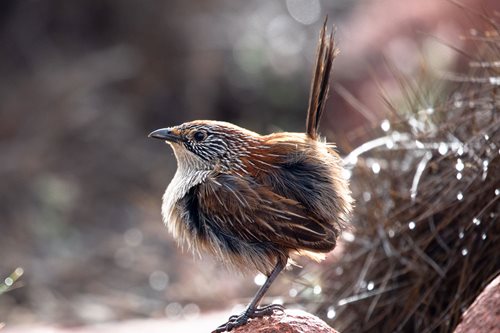
Short-tailed Grasswren at Hiltaba; photo James Dorey
Short-tailed Grasswrens (Amytornis merrotsyi) are only found in the arid ranges of South Australia. The species consists of two sub species: the Gawler Ranges Short-tailed Grasswren (Amytornis merrotsyi pedleri) and the Flinders Ranges Short-tailed Grasswren (Amytornis merrotsyi merrotsyi). They are both listed as endangered due to their highly restricted geographic distribution and recent declining numbers, resulting from threats such as fire, over-grazing, predation by cats and foxes, and variable climate.
This cryptic bird that is heard but rarely seen lives in stony spinifex (Triodia) hills of the Gawler and Flinders Ranges.
Hiltaba Nature Reserve is home to one of the three main subpopulations of the Gawler Ranges Short-tailed Grasswrens, and for that reason Nature Foundation is very concerned with the status of the species and its long-term survival. In parallel with our threat abatement work (fox and goat control) we are building on recent survey work completed by the Department for Environment and Water staff to setup a rigorous monitoring program aimed at tracking changes in the population size and distribution at Hiltaba.
Thick-billed Grasswrens
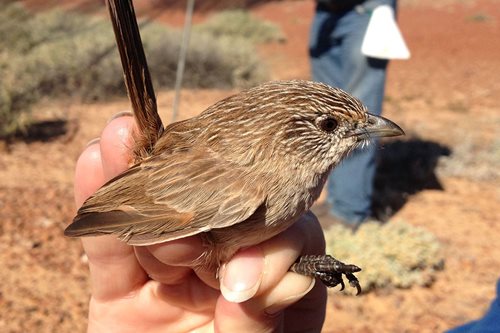
Thick-billed Grasswren at Witchelina; photo Dr Marina Louter
Thick-Billed Grasswrens (Amytornis modestus) once occurred patchily between central Australia and inland eastern New South Wales and declined dramatically last century due to a reduction in habitat quality resulting from excessive grazing by domestic livestock and rabbits, drought and predation. The species is now almost entirely restricted to South Australia and north west New South Wales.
Five of seven subspecies are now threatened or near threatened: Amytornis modestus raglessi, A. m. curnamona, A. m indulkanna, A. m obscurior and A. m. cowarie and 2 are extinct: A. m. inexpectatus and A. m. modestus.
The Thick-Billed Grasswren sub species A. m. raglessi occupies a restricted range east of the northern Flinders Ranges and occurs at Witchelina Nature Reserve where considerable effort to conserve the species has occurred since we purchased the property in 2009. This includes funding two PhD projects investigating the behaviour, ecology, and genetics of the species. Two recent grants will allow us to expand our survey and monitoring program to neighbouring pastoral stations.
Native fish
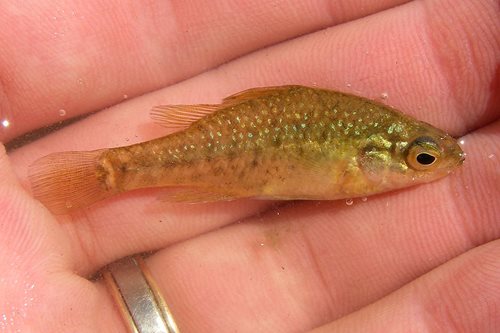
Yarra Pygmy Perch; photo Michael Hammer
The waters of the Watchalunga Nature Reserve provide important aquatic habitat to support freshwater fishes. A baseline fish survey of the reserve, conducted in spring 2018, and a repeat survey in spring 2019 revealed a diverse fish community with reasonably low numbers of non-native species. A recent eDNA project detected the vulnerable Murray Hardyhead and may be a refuge for the nationally-listed Yarra Pygmy Perch (vulnerable).
Murray Hardyhead
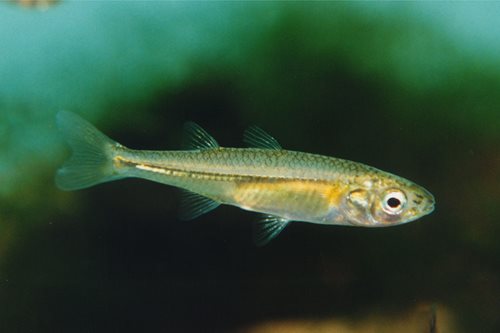
Murray Hardyhead; photo Michael Hammer
The Murray Hardyhead (Craterocephalus fluviatilis), listed as nationally endangered since 1999, is a small freshwater fish that was previously widespread across the Lower Murray River and Lower Lakes but now only survives in a handful of locations. This species was recently discovered in a wetland near Lyrup in the Riverland.
These fish, up to 9cm long, feed on micro-crustaceans, aquatic insects and algae, and are adapted to saline wetlands that contain a wide range of aquatic vegetation and snags which are used for habitat and breeding.
The Murraylands and Riverland Landscape Board Wetlands Team have worked closely with Nature Foundation, the Commonwealth Environmental Water Holder, Berri Barmera Landcare and Central Irrigation Trust as part of a collaborative partnership to manage the Murray Hardyhead population in this particular lagoon.
Surveys conducted between spring 2019 and spring 2020 saw an increase in the number of the fish from less than 100 to 24,500. These are the highest numbers observed anywhere in the Murray-Darling Basin for some time, and demonstrates how collaborative management efforts can promote favourable habitat to support this endangered fish.
Watchalunga Nature Reserve may be a refuge for the Murray Hardyhead.